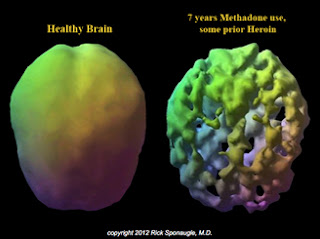Some "Sobering" Stats
Opioid Addiction
- Opioids are a class of drugs that include the illicit drug heroin as well as the licit prescription pain relievers oxycodone, hydrocodone, codeine, morphine, fentanyl and others.
- Opioids are chemically related and interact with opioid receptors on nerve cells in the brain and nervous system to produce pleasurable effects and relieve pain.
- Addiction is a primary, chronic and relapsing brain disease characterized by an individual pathologically pursuing reward and/or relief by substance use and other behaviors.
- Of the 21.5 million Americans 12 or older that had a substance use disorder in 2014, 1.9 million had a substance use disorder involving prescription pain relievers and 586,000 had a substance use disorder involving heroin.
- It is estimated that 23% of individuals who use heroin develop opioid addiction.
National Opioid Overdose Epidemic
- Drug overdose is the leading cause of accidental death in the US, with 47,055 lethal drug overdoses in 2014. Opioid addiction is driving this epidemic, with 18,893 overdose deaths related to prescription pain relievers, and 10,574 overdose deaths related to heroin in 2014.
- From 1999 to 2008, overdose death rates, sales and substance use disorder treatment admissions related to prescription pain relievers increased in parallel. The overdose death rate in 2008 was nearly four times the 1999 rate; sales of prescription pain relievers in 2010 were four times those in 1999; and the substance use disorder treatment admission rate in 2009 was six times the 1999 rate.
- In 2012, 259 million prescriptions were written for opioids, which is more than enough to give every American adult their own bottle of pills.
- Four in five new heroin users started out misusing prescription painkillers. As a consequence, the rate of heroin overdose deaths nearly quadrupled from 2000 to 2013. During this 14-year period, the rate of heroin overdose showed an average increase of 6% per year from 2000 to 2010, followed by a larger average increase of 37% per year from 2010 to 2013.
- 94% of respondents in a 2014 survey of people in treatment for opioid addiction said they chose to use heroin because prescription opioids were “far more expensive and harder to obtain.”
Adolescents (12 to 17 years old) - In 2014, 467,000 adolescents were current nonmedical users of pain reliever, with 168,000 having an addiction to prescription pain relievers.
- In 2014, an estimated 28,000 adolescents had used heroin in the past year, and an estimated 16,000 were current heroin users. Additionally, an estimated 18,000 adolescents had heroin a heroin use disorder in 2014.
- People often share their unused pain relievers, unaware of the dangers of nonmedical opioid use. Most adolescents who misuse prescription pain relievers are given them for free by a friend or relative.
- The prescribing rates for prescription opioids among adolescents and young adults nearly doubled from 1994 to 2007.
Women
- Women are more likely to have chronic pain, be prescribed prescription pain relievers, be given higher doses, and use them for longer time periods than men. Women may become dependent on prescription pain relievers more quickly than men.
- 48,000 women died of prescription pain reliever overdoses between 1999 and 2010.
- Prescription pain reliever overdose deaths among women increased more than 400% from 1999 to 2010, compared to 237% among men.
- Heroin overdose deaths among women have tripled in the last few years. From 2010 through 2013, female heroin overdoses increased from 0.4 to 1.2 per 100,000.



Comments
Post a Comment